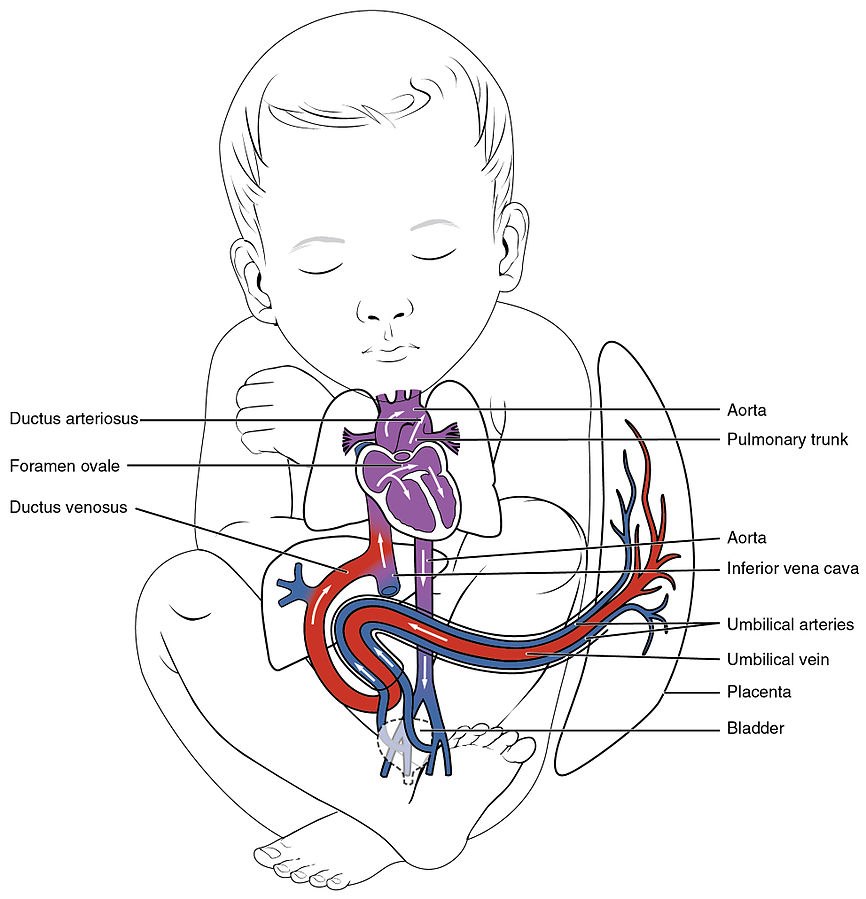
The pulmonary trunk and systemic aorta of the fetus, is connected by?
a. Ligamentum arteriosum
b. Ductus arteriosus
c. Ductus arteriosum
d. Chordae tendineae
Answer
465.3k+ views
Hint: The pulmonary trunk of the fetus is connected to the systemic aorta via the ligamentum arteriosum, which is a remnant of the obliterated ductus arteriosus. The ductus arteriosus transports blood directly from the pulmonary trunk into the aorta and bypasses the pulmonary trunk into the aorta and bypasses the lungs of the fetus.
Complete answer:
The pulmonary trunk is a short artery which transports deoxygenated blood from the heart towards the lungs and ductus arteriosus acts as a shunt between the pulmonary artery and the aorta during fetal development. Before birth of a child, the ductus arteriosus transfers blood right from the pulmonary arteries to the aorta. This phenomenon happens to avoid the circulation of blood through the lungs, which are non-functional at that stage.
In the fetus, before returning to the body, the blood is oxygenated in the placenta. Amniotic fluid fills the lungs and cannot therefore be used to oxygenate the blood. Preferably, the arterioles in the lungs confine the quantity of blood flow that can pass through.

Hence, the correct answer is option (C).
Note: The ductus arteriosus is also known as ductus botalli. Basically it is a blood vessel in the developing stage of the fetus. Ductus arteriosus allows most of the blood from the right ventricle to bypass the fetus fluid filled non-functioning lungs. It becomes ligamentum arteriosum upon closure. Sometimes, ductus arteriosus fails to close after birth, which results in a condition, known as patent ductus arteriosus. In this condition abnormal flow of blood can occur from the aorta to the pulmonary artery. If it is left untreated, this can lead to pulmonary hypertension, which can be followed by ventricular heart failure, as well as possible cardiac arrhythmias.
Complete answer:
The pulmonary trunk is a short artery which transports deoxygenated blood from the heart towards the lungs and ductus arteriosus acts as a shunt between the pulmonary artery and the aorta during fetal development. Before birth of a child, the ductus arteriosus transfers blood right from the pulmonary arteries to the aorta. This phenomenon happens to avoid the circulation of blood through the lungs, which are non-functional at that stage.
In the fetus, before returning to the body, the blood is oxygenated in the placenta. Amniotic fluid fills the lungs and cannot therefore be used to oxygenate the blood. Preferably, the arterioles in the lungs confine the quantity of blood flow that can pass through.

Hence, the correct answer is option (C).
Note: The ductus arteriosus is also known as ductus botalli. Basically it is a blood vessel in the developing stage of the fetus. Ductus arteriosus allows most of the blood from the right ventricle to bypass the fetus fluid filled non-functioning lungs. It becomes ligamentum arteriosum upon closure. Sometimes, ductus arteriosus fails to close after birth, which results in a condition, known as patent ductus arteriosus. In this condition abnormal flow of blood can occur from the aorta to the pulmonary artery. If it is left untreated, this can lead to pulmonary hypertension, which can be followed by ventricular heart failure, as well as possible cardiac arrhythmias.
Recently Updated Pages
Master Class 12 Economics: Engaging Questions & Answers for Success

Master Class 12 Maths: Engaging Questions & Answers for Success

Master Class 12 Biology: Engaging Questions & Answers for Success

Master Class 12 Physics: Engaging Questions & Answers for Success

Master Class 12 Business Studies: Engaging Questions & Answers for Success

Master Class 12 English: Engaging Questions & Answers for Success

Trending doubts
Which are the Top 10 Largest Countries of the World?

Differentiate between homogeneous and heterogeneous class 12 chemistry CBSE

Draw a labelled sketch of the human eye class 12 physics CBSE

What is the Full Form of PVC, PET, HDPE, LDPE, PP and PS ?

What is a transformer Explain the principle construction class 12 physics CBSE

What are the major means of transport Explain each class 12 social science CBSE




